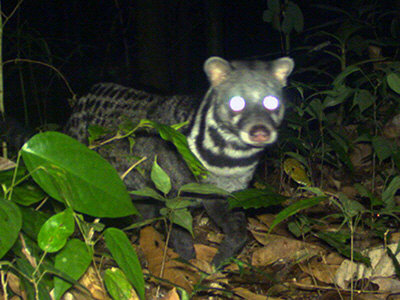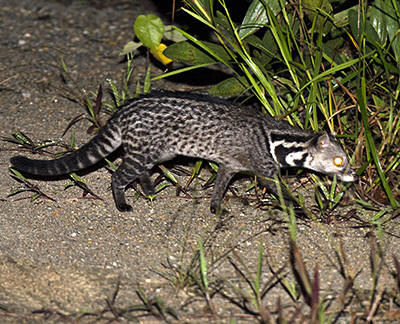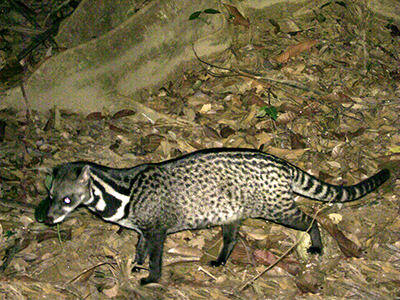
Fig 1

Fig 2

Fig 3
|
Order : CARNIVORA
Family : Viverridae
Species : Viverra tangalunga
Head-body length : 61-67 cm
Tail length : 28-35 cm
Weight : up to 5 kg
The Malay Civet, or Oriental Civet, inhabits lowland
and lower montane, primary and secondary forest to around 1200 metres
elevation. It adapts well to disturbed habitats. It is fully nocturnal and
mainly, but not exclusively, a ground dweller.
It is omnivorous, and feeds on a variety of invertebrates, such as insects
or worms, small vertebrates such as lizards, and forest fruits. In rural
areas adjacent to good forest, this civet may explore the margins of
villages in search of food scraps. It will also eat carrion.
It is best identified by the numerous, incomplete pale bands on the tail and
the small, dark spots on the flanks. A dark line extends along the back and
onto the entire length of the tail. There are thick, well-defined black and
white markings on the neck.
Its body is stocky, its legs are relatively short and its head is pointed
and fox-like.
The Malay Civet occurs in Peninsular Malaysia, Sumatra, Riau Archipelago,
Borneo, Sulawesi and other island groups of Indonesia including the
Moluccas. It also occurs on many islands of the Philippines.
In 2012 a single individual was photographed in Singapore by an infrared
trail camera, but has not been recorded since and the species is thus
considered to be very rare in that country (Lim et al, 2012).
Fig 1 : Example from Lambir Hills, Sarawak, Borneo. The robust body
and broad muzzle suggest this is an adult.
Fig 2 : This example is
relatively small and is likely to be a juvenile.
Fig 3 : Typical specimen from lowland, primary forest.
References :
Francis, C.M. 2019. A Field Guide to the Mammals of South-east Asia.
Second Edition. New Holland. 416 pp.
Lim, N. T., & Ou Yang, X. (2012). Occurrence of the Malay civet, Viverra
tangalunga,(Mammalia: Carnivora: Viverridae) in Singapore. Nature in
Singapore, 5, 79-81.
|